| Revision as of 19:14, 11 September 2014 editWarriorLut (talk | contribs)43 edits →Popular drugs← Previous edit | Revision as of 20:17, 11 September 2014 edit undoSignedzzz (talk | contribs)Extended confirmed users20,559 edits Not finished with pic yetNext edit → | ||
| Line 1: | Line 1: | ||
| {{Use dmy dates|date=September 2014}} | {{Use dmy dates|date=September 2014}} | ||
| ⚫ | ] | ||
| ⚫ | ], contained in coffee and other beverages, is the most widely used ] in the world. 90% of adults consume the substance on a daily basis in North America.<ref name="New Scientist: Coffee: The demon drink?">{{cite web | url = http://www.newscientist.com/article/mg18725181.700 | title = Coffee: The demon drink? | accessdate = 2014-05-01 | author = Richard Lovett | date = 2005-09-24 }}</ref>]] | ||
| '''Recreational drug use''' is the use of a ] for ]. DNA studies have shown that humans have used recreational drugs for millions of years. The drugs most favoured for recreational use commonly fall within the scope of ] directives banning their use. One in ten US citizens have been arrested for ]s. Since it was first introduced in the early twentieth century, ] has been used to victimise racial minorities. In the US, one in fifteen black males over the age of 18 is in prison.<ref name=huff/> | '''Recreational drug use''' is the use of a ] for ]. DNA studies have shown that humans have used recreational drugs for millions of years. The drugs most favoured for recreational use commonly fall within the scope of ] directives banning their use. One in ten US citizens have been arrested for ]s. Since it was first introduced in the early twentieth century, ] has been used to victimise racial minorities. In the US, one in fifteen black males over the age of 18 is in prison.<ref name=huff/> | ||
| Line 8: | Line 9: | ||
| ==Prohibition== | ==Prohibition== | ||
| ⚫ | ] | ||
| ] agents burning ] seized in Afghanistan, 2008]] | ] agents burning ] seized in Afghanistan, 2008]] | ||
| {{main|United States incarceration rate|Race and the War on Drugs}} | {{main|United States incarceration rate|Race and the War on Drugs}} | ||
| Line 116: | Line 117: | ||
| Plants containing caffeine: | Plants containing caffeine: | ||
| ⚫ | ], contained in coffee and other beverages, is the most widely used ] in the world. 90% of adults consume the substance on a daily basis in North America.<ref name="New Scientist: Coffee: The demon drink?">{{cite web | url = http://www.newscientist.com/article/mg18725181.700 | title = Coffee: The demon drink? | accessdate = 2014-05-01 | author = Richard Lovett | date = 2005-09-24 }}</ref>]] | ||
| * ] | * ] | ||
| * ] (caffeine in tea is sometimes called theine) – also contains ] | * ] (caffeine in tea is sometimes called theine) – also contains ] | ||
Revision as of 20:17, 11 September 2014

Recreational drug use is the use of a drug for pleasure. DNA studies have shown that humans have used recreational drugs for millions of years. The drugs most favoured for recreational use commonly fall within the scope of United Nations directives banning their use. One in ten US citizens have been arrested for drug related crimes. Since it was first introduced in the early twentieth century, drug prohibition has been used to victimise racial minorities. In the US, one in fifteen black males over the age of 18 is in prison.
Between 2006 and 2013, the Mexican drug war claimed 120,000 lives. Children have been routinely targeted. In a 2011 interview, when questioned about these casualty figures, including the killing of over 1,100 children in 2009, Michele Leonhart, the head of the US Drug Enforcement Administration, said:
"It may seem contradictory, but the unfortunate level of violence is a sign of success in the fight against drugs.”
Prohibition
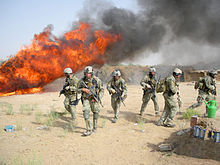
"In the nineteenth century, it was understood that certain middle class women and professional men had the 'drug habit.' ...Private weaknesses like these did not lead to serious restrictions on the availability of opiates or cocaine, let alone the criminalisation of their non-medical use. Once the 'dope-fiend' was identified as a species, however, drugs came to be regarded as properly a police matter. The outlawing of drugs was the consequence, not of their pharmacology, but of their association with social groups perceived as potentially dangerous." (Plant & Plant, 1992)
The US Obama administration spends $51 billion per year on drug enforcement. 120,000 died in the Mexican drug war between 2006 and 2013, and 27,000 were declared missing. Currently, one in three African American males aged 20–29 is under some form of criminal justice supervision, and one in ten in their twenties and early thirties is in prison or jail. The ideology of the White House Office of National Drug Control Policy is outlined in this statement made in 2011:
“Drug addiction is a disease that can be successfully prevented and treated. ...The Global Commission claims that there is a “taboo” on debating and discussing alternative drug policy approaches and strategies. On the contrary (sic), the balanced approach of supply reduction and demand reduction has been frequently and fully debated, discussed, and modified over time. This balanced approach has succeeded in containing the growth of illegal drug use in the US and limiting the social costs of this epidemic problem."
Portugal legalised "small amounts" of recreational drugs in 2001. In August 2013, Uruguay's House of Deputies voted in favour of a bill to legalize marijuana, which was expected to be ratified in the autumn. The news brought widespread condemnation. Pope Francis vehemently denounced drug legalisation during a tour of Brazil in July, just prior to the vote. The UN International Narcotics Control Board also immediately condemned the decision, stating that "smoking cannabis is more carcinogenic than smoking tobacco". In May 2014, the new regulations came into force. The INCB continued to criticise the Uruguayan government, suggesting that legalization would increase illegal drug trafficking. Its president, Raymond Yans, claimed repeatedly that Uruguayan officials had avoided meeting with UN officials to discuss the new policy. President of Uruguay, José Mujica, denied the accusation: “Tell this old guy not to lie. Any guy in the street can meet with me. Let him come to Uruguay and meet with me whenever he wants… He thinks that because he’s in an international position, he can tell whatever lie he wants.”
Evolution
In Psychotropic substance-seeking: evolutionary pathology or adaptation? (2000) it is stated that "humans have shared a co-evolutionary relationship with psychoactive plant substances for millions of years." Archaeological and historical evidence of drug use suggests that "for people in the past, psychotropic plant substances were as much a mundane everyday item as they are for many people today."
Archaeological evidence indicates that recreational drug use began at least 200 million years ago among the distant ancestors of modern primates. At the beginning of the modern age it was a unifying cultural feature of globally scattered human populations, who took advantage of whatever psychoactive drugs were locally available:

"A common belief is that psychotropic plant chemicals evolved recurrently throughout evolutionary history. Archaeological records indicate the presence of psychotropic plants and drug use in ancient civilizations as far back as early hominid species about 200 million years ago. Roughly 13,000 years ago, the inhabitants of Timor commonly used betel nut (Areca catechu), as did those in Thailand around 10,700 years ago. At the beginning of European colonialism, and perhaps for 40,000 years before that, Australian aborigines used nicotine from two different indigenous sources: pituri plant (Duboisia hopwoodii) and Nicotiana gossel. North and South Americans also used nicotine from their indigenous plants N. tabacum and N. rustica. Ethiopians and northern Africans were documented as having used an ephedrine-analog, khat (Catha edulis), before European colonization. Cocaine (Erythroxylum coca) was taken by Ecuadorians about 5,000 years ago and by the indigenous people of the western Andes almost 7,000 years ago. The substances were popularly administered through the buccal cavity within the cheek. Nicotine, cocaine, and ephedrine sources were first mixed with an alkali substance, most often wood or lime ash, creating a free base to facilitate diffusion of the drug into the blood stream. Alkali paraphernalia have been found throughout these regions and documented within the archaeological record. Although the buccal method is believed to be most standard method of drug administration, inhabitants of the Americas may have also administered substances nasally, rectally, and by smoking."
The evolutionary "paradox" of the human propensity to use botanical psychotropics is raised in a 2008 Royal Society paper that argues for a "synthesis of ecological and neurobiological perspectives". Based on an analysis of the evolution of human hepatic enzymes, which metabolize environmental chemicals, the authors reject the theory that recreational drug use is an evolutionary novelty, or mismatch. They examine the "possibility that humans may have evolved to counter-exploit plant neurotoxins":
"Neurobiological models of drug abuse propose that drug use is initiated and maintained by rewarding feedback mechanisms. However, the most commonly used drugs are plant neurotoxins that evolved to punish, not reward, consumption by animal herbivores. Reward models therefore implicitly assume an evolutionary mismatch between recent drug-profligate environments and a relatively drug-free past in which a reward centre, incidentally vulnerable to neurotoxins, could evolve. By contrast, emerging insights from plant evolutionary ecology and the genetics of hepatic enzymes, particularly cytochrome P450, indicate that animal and hominid taxa have been exposed to plant toxins throughout their evolution. Specifically, evidence of conserved function, stabilizing selection, and population-specific selection of human cytochrome P450 genes indicate recent evolutionary exposure to plant toxins, including those that affect animal nervous systems. Thus, the human propensity to seek out and consume plant neurotoxins is a paradox with far-reaching implications for current drug-reward theory. We sketch some potential resolutions of the paradox, including the possibility that humans may have evolved to counter-exploit plant neurotoxins. Resolving the paradox of drug reward will require a synthesis of ecological and neurobiological perspectives of drug seeking and use."
History

Mediterranean
In the Odyssey IX, Odysseus tells how adverse north winds blew him and his men off course as they were rounding Cape Malea, the southernmost tip of the Peloponnese, heading westwards for Ithaca:
"I was driven thence by foul winds for a space of 9 days upon the sea, but on the tenth day we reached the land of the Lotus-eaters, who live on a food that comes from a kind of flower. Here we landed to take in fresh water, and our crews got their mid-day meal on the shore near the ships. When they had eaten and drunk I sent two of my company to see what manner of men the people of the place might be, and they had a third man under them. They started at once, and went about among the Lotus-eaters, who did them no hurt, but gave them to eat of the lotus, which was so delicious that those who ate of it left off caring about home, and did not even want to go back and say what had happened to them, but were for staying and munching lotus with the Lotus-eaters without thinking further of their return; nevertheless, though they wept bitterly I forced them back to the ships and made them fast under the benches. Then I told the rest to go on board at once, lest any of them should taste of the lotus and leave off wanting to get home, so they took their places and smote the grey sea with their oars."
The flower is often depicted in ancient Egyptian art, in connection with festivities or with the magical rite of passage into death. Herodotus, in the fifth century BC, was sure that the lotus-eaters (λωτοφάγοι) still existed in his day, in coastal Libya:
A promontory jutting out into the sea from the country of the Gindanes is inhabited by the lotus-eaters, who live entirely on the fruit of the lotus-tree. The lotus fruit is about the size of the lentisk berry and in sweetness resembles the date. The lotus-eaters even succeed in obtaining from it a sort of wine.
Herodotus also described the method used by the Scythians to consume marijuana, which involved full immersion in smoke inside a sealed tent. The practise was claimed by the men of the tribe to be preferable to washing in water. Ancient Greeks and Romans are understood to have consumed a significant quantity of drugs, leading the "father of botany," Theophrastus to observe, "The virtues of all drugs become weaker to those who are accustomed to them, and in some cases become entirely ineffective."
"Greeks and Romans intentionally exposed themselves to the vapours of burning plants during the practise of "fumigation," a process whereby the drug user breathed in the fumes of various substances, anything from ordinary incense to potent herbs. This was a commonplace activity in recreational, religious and medical settings... Greeks and Romans used opium, anticholinergics, and numerous botanical toxins to induce states of mental euphoria, create hallucinations, and alter their own consciousness." (The Chemical Muse: Drug Use and the Roots of Western Civilization, Hillman, 2008)
China

Cannabis has been continuously cultivated in China since Neolithic times. Pottery fragments from 10,000 BC contain imprints of hemp rope. The medical encyclopedia Pen-tsao Ching, a compilation of oral traditions written between about 300 BC and 200 AD, lists cannabis among hundreds of other drugs. It was purportedly written by the legendary Emperor Shennong, who was said to have been responsible for teaching the Chinese about agriculture and the use of botanical drugs. The Chinese word for cannabis is Ma, 麻, which derives from a Zhou Dynasty bronze script ideograph showing 林 "plants" drying in a 广 "shed; shack". Ma has the extended meaning of "numbed; tingling" (e.g., mazui 麻醉 "anaesthetic; narcotic.") In the second century CE, hash was mixed with wine to produce an anaesthetic used for surgical procedures ranging from resectioning of the intestines to chest incisions. The legendary Taoist xian 仙 "immortal; transcendent" Magu 麻姑, literally "Cannabis maid," has traditionally been associated with the elixir of life. Magu xian shou (麻姑獻壽 "Magu gives her birthday greetings") is a popular motif in Chinese art.
The Pen-Tsao Ching states that "The flowers when they burst (when the pollen is scattered) are called 麻蕡 or 麻勃 . The best time for gathering is the 7th day of the 7th month. The seeds are gathered in the 9th month. The seeds which have entered the soil are injurious to man. It grows on Mount Tai." The c. 570 CE Taoist encyclopedia Wushang Biyao (Supreme Secret Essentials) states that cannabis was burnt in ritual censers. Sinologist Joseph Needham CH, FRS, FBA has contended that "all in all there is much reason for thinking that the ancient Taoists experimented systematically with hallucinogenic smokes, using techniques which arose directly out of liturgical observance. ...At all events the incense-burner remained the centre of changes and transformations... fire, combustion, disintegration, vision, communication with spiritual beings, and assurances of immortality. Wai tan and nei tan met around the incense-burner. Might one not indeed think of it as their point of origin?"
America
In 2008, archaeologists working in the Caribbean island of Carriacou announced the first significant find of ancient 'drug paraphernalia', including ceramic bowls and tubes for inhaling drug fumes or powders. The items had been transported 400 miles to the island after being manufactured in South America some time between 400BC and 100BC. It has been suggested by scientists that the drug they were used for was cohoba, an hallucinogen derived from mimosa beans.
Popular drugs

The following substances, all widely illegal unless stated otherwise, are ranked here in order of world-wide popularity:
- caffeine (from coffee, tea and energy drinks) – Legal in almost all parts of the world, but not consumed by members of some religions.
- alcohol – Illegal in several Muslim countries. Most drinking alcohol is ethanol, CH
3CH
2OH, produced by the fermentation of sugars by yeasts. It is an IARC 'Group 1' carcinogen and a teratogen. - tobacco – Nicotiana tabacum. A legal drug, containing nicotine, which crosses the blood–brain barrier in 10-20 seconds. It mimics the action of the neurotransmitter acetylcholine at nicotinic acetylcholine receptors in the brain and the neuromuscular junction. The neuronal forms of the receptor are present both post-synaptically (involved in classical neurotransmission) and pre-synaptically, where they can influence the release of multiple neurotransmitters.
- cannabis – Contains at least 85 cannabinoids. The primary psychoactive component is THC, which mimics the neurotransmitter anandamide, named after the Hindu ananda, "joy, bliss, delight." THC eases moderate pain and appears to be neuroprotective. It reduces neuroinflammation and stimulates neurogenesis.
- MDMA – has stimulant and psychedelic effects, in ecstasy pills or in crystal form, known as "Wes Welkers"
- cocaine – When transformed into its freebase form, crack, the cocaine vapour may be inhaled directly. This is thought to increase bioavailability, but has also been found to be toxic, due to the production of methylecgonidine during pyrolysis.
- amphetamines – Prescribed for ADHD. A potent central nervous system stimulant, in the 1940s and 50s methamphetamine was used by Axis and Allied troops in World War II, and, later on, other armies, and by Japanese factory workers. It increases muscle strength and fatigue resistance and improves reaction time. Unlike amphetamine, methamphetamine is neurotoxic, damaging dopamine neurons. As a result of this brain damage, chronic use may lead to post acute withdrawal syndrome.
- magic mushrooms – Until 1963, when it was chemically analysed by Albert Hofmann, it was completely unknown to modern science that psilocybe semilanceata ('Liberty Cap', common throughout Europe) contains psilocybin, an hallucinogen previously identified only in species native to Mexico, Asia and North America.
- LSD – A popular ergoline derivative, that was first synthesized in 1938 by Hofmann. However, he failed to notice its psychedelic potential until 1943. In the 1950s, it was used in psychological therapy, and, covertly, by the CIA in Project MKULTRA, in which the drug was administered to unwitting US and Canadian citizens. It played a central role in 1960s 'counter-culture', and was banned in October 1968 by US President Lyndon B Johnson.
- opiates and opioids – Available by prescription.
- tranquilizers - barbiturates, benzodiazepines (commonly prescribed for anxiety; known to cause dementia and post acute withdrawal syndrome)
- nitrous oxide - freely available; used for whipping cream
- ketamine - used by paramedics in emergency situations for its dissociative and analgesic qualities
- 'mystery white powders' – (street drug labelling and composition can be unclear)
- amyl nitrite - a vasodilator (legal)
Some other well known substances:
- DMT - primary ingredient in ayahuasca, can also be smoked in a crack pipe; briefly (c. 30 minutes) causes a "total loss of connection to external reality"
- research chemicals - 2C variants, etc.
- salvia divinorum - hallucinogenic Mexican herb in the mint family; not considered recreational, most likely due to the nature of the hallucinations (legal)
- khat - containing cathine and cathinone (stimulants)
- solvents - legal
Further information
Routes of administration

Drugs most often associated with a particular route of administration:
- intravenous injection (see also the article Drug injection) – morphine and heroin, less commonly other opioids or stimulants like cocaine or amphetamine, but almost every substance (with some exceptions) can be injected
- smoking (see also the section below) – tobacco, cannabis, opium, methamphetamine, crack cocaine and heroin (diamorphine as freebase) known as chasing the dragon
- insufflation – snuff (a form of smokeless tobacco), amphetamine and cocaine
- inhalation – all inhalants (listed above)
- chewing, absorbing sublingually, placing under the lip, etc. – some forms of smokeless tobacco (e.g. dipping tobacco, snus), LSD blotters, coca leaves with slaked lime, paan (see betel), some hallucinogens
- intrarectal – administering into the rectum, most water soluble drugs can be used this way
- transdermal patches with prescription drugs – e.g. methylphenidate (Daytrana) and fentanyl
- oral intake – caffeine, ethanol, hash cakes (cannabis), nutmeg, datura, psilocybin mushrooms, coca tea, poppy tea, laudanum, GHB, ecstasy pills with MDMA and/or various other substances (mainly stimulants and psychedelics), prescription and over-the-counter drugs (ADHD and narcolepsy medications, sleeping pills, anxiolytics, sedatives, cough suppressants, benzydamine, ephedrine, pseudoephedrine, morphine, codeine, opioids and others)
Plants, fungi and animals
See also: List of psychedelic plants- kratom – mitragynine, mitraphylline, 7-hydroxymitragynine, raubasine and corynantheidine
- ephedra – ephedrine
- damiana
- Calea zacatechichi
- Silene capensis
- valerian – valerian (the chemical with the same name)
- various plants like chacruna, jurema, vilca, and yopo – 5-MeO-DMT
- Morning glory and Hawaiian Baby Woodrose – lysergic acid amide (LSA, ergine)
- Ayahuasca
- Tabernanthe iboga ("Iboga") – ibogaine
- Areca catechu (see: betel and paan) – arecoline
- Rauvolfia serpentina – rauwolscine
- yohimbe (Pausinystalia yohimbe) – yohimbine, corynantheidine
Solanaceae plants – contain atropine, hyoscyamine and scopolamine
- datura
- deadly nightshade atropa belladona
- henbane
- mandrake (Mandragora)
- other Solanaceae
Plants containing caffeine:
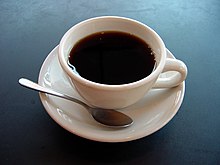
- coffee
- tea (caffeine in tea is sometimes called theine) – also contains theanine
- guarana (caffeine in guarana is sometimes called guaranine)
- yerba mate (caffeine in yerba mate is sometimes called mateine)
- cocoa
- kola
Fungi:
- psilocybin mushrooms – psilocybin and psilocin
- various Amanita mushrooms – bufotenin
- Amanita muscaria – ibotenic acid and muscimol
- Claviceps purpurea and other Clavicipitaceae – ergotamine (not psychoactive itself but used in synthesis of LSD)
Psychoactive animals:
- hallucinogenic fish
- psychoactive toads – bufotenin, Bufo alvarius (Colorado River toad or Sonoran Desert toad) also contains 5-MeO-DMT
Depressants
Depressants are psychoactive drugs that temporarily diminish the function or activity of a specific part of the body or mind. Examples of these kinds of effects may include anxiolysis, sedation, and hypotension. Due to their effects typically having a "down" quality to them, depressants are also occasionally referred to as "downers". Stimulants or "uppers", which increase mental and/or physical function, are in stark contrast to depressants and are considered to be their functional opposites. Depressants are widely used throughout the world as prescription medicines and as illicit substances. When these are used, effects may include anxiolysis, analgesia, sedation, somnolence, cognitive/memory impairment, dissociation, muscle relaxation, lowered blood pressure/heart rate, respiratory depression, anesthesia, and anticonvulsant effects. Some are also capable of inducing feelings of euphoria. Depressants exert their effects through a number of different pharmacological mechanisms, the most prominent of which include facilitation of GABA and/or opioid activity, and inhibition of adrenergic, histamine and/or acetylcholine activity.
Antihistamines
Antihistamines (or "histamine antagonists") inhibit the release or action of histamine. "Antihistamine" can be used to describe any histamine antagonist, but the term is usually reserved for the classical antihistamines that act upon the H1 histamine receptor. Antihistamines are used as treatment for allergies. Allergies are caused by an excessive response of the body to allergens, such as the pollen released by grasses and trees. An allergic reaction causes release of histamine by the body. Other uses of antihistamines are to help with normal symptoms of insect stings even if there is no allergic reaction. Their recreational appeal exists mainly due to their anticholinergic properties, that induce anxiolysis and, in some cases such as diphenhydramine, chlorpheniramine, and orphenadrine, a characteristic euphoria at moderate doses.
Hallucinations and possibly delirium resembling the effects of Datura stramonium can result if the drug is taken in much higher than therapeutical dosages.
Antihistamines are widely available over the counter at drug stores (without a prescription), in the form of allergy medication and some cough medicines. They are sometimes used in combination with other substances such as alcohol. The most common unsupervised use of antihistamines in terms of volume and percentage of the total is perhaps in parallel to the medicinal use of some antihistamines to stretch out and intensify the effects of opioids and depressants. The most commonly used are hydroxyzine, mainly to stretch out a supply of other drugs, as in medical use, and the above-mentioned ethanolamine and alkylamine-class first-generation antihistamines, which are – once again as in the 1950s – the subject of medical research into their anti-depressant properties.
For all of the above reasons, the use of medicinal scopolamine for recreational uses is also seen.
Analgesics
Analgesics (also known as "painkillers") are used to relieve pain (achieve analgesia). The word analgesic derives from Greek "αν-" (an-, "without") and "άλγος" (álgos, "pain"). Analgesic drugs act in various ways on the peripheral and central nervous systems; they include paracetamol (para-acetylaminophenol, also known in the US as acetaminophen), the non-steroidal anti-inflammatory drugs (NSAIDs) such as the salicylates, and opioid drugs such as hydrocodone, codeine, heroin and oxycodone. Some further examples of the brand name prescription opiates and opioid analgesics that may be used recreationally include Vicodin, Lortab, Norco (hydrocodone), Avinza, Kapanol (morphine), Opana, Paramorphan (oxymorphone), Dilaudid, Palladone (hydromorphone), and OxyContin (oxycodone), kratom.
Tranquilizers
- Barbiturates
- Benzodiazepines
- Nonbenzodiazepines
- Ethanol (drinking alcohol; ethyl alcohol)
- Others
- carisoprodol (Soma)
- chloral hydrate
- diethyl ether
- ethchlorvynol (Placidyl; "jelly-bellies")
- gabapentin (Neurontin)
- gamma-butyrolactone (GBL, a prodrug to GHB)
- gamma-hydroxybutyrate (GHB; G; Xyrem; "Liquid Ecstasy", "Fantasy")
- glutethimide (Doriden)
- kava (from Piper methysticum; contains kavalactones)
- ketamine
- meprobamate (Miltown)
- methaqualone (Sopor, Mandrax; "Quaaludes")
- phenibut
- pregabalin (Lyrica)
- propofol (Diprivan)
- theanine (found in Camellia sinensis, the tea plant)
- valerian (from Valeriana officinalis)
Euphoriants
See also: Euphoriant and Euphoria § Pharmacologically-induced- Alcohol: "Euphoria, the feeling of well-being, has been reported during the early (10–15 min) phase of alcohol consumption" (e.g., beer, wine or spirits)
- Passion Flower (Passiflora incarnata) is widely used as a sedative that has calming effects on the nervous system and acts as a sleep aid. One harmala alkaloid present in this herb in the form of harmine is thought to induce meditative and euphoric effects.
- Catnip Catnip contains a sedative known as nepetalactone that activates opioid receptors. In cats it elicits sniffing, licking, chewing, head shaking, rolling, and rubbing which are indicators of pleasure. Catnip does not however, induce the same response in humans.
- Cannabis Tetrahydrocannabinol, the main psychoactive ingredient in this plant can have sedative and euphoric properties.
- Stimulants: "Psychomotor stimulants produce locomotor activity (the subject becomes hyperactive), euphoria, (often expressed by excessive talking and garrulous behaviour), and anorexia. The amphetamines are the best known drugs in this category..."
- MDMA: The "euphoriant drugs such as MDMA (‘ecstasy’) and MDEA (‘eve’)" are popular amongst young adults. MDMA "users experience short-term feelings of euphoria, rushes of energy and increased tactility."
- Opium: This "drug derived from the unripe seed-pods of the opium poppy ... produces drowsiness and euphoria and reduces pain. Morphine and codeine are opium derivatives."
Hallucinogens
Hallucinogens can be divided into three broad categories: psychedelics, dissociatives, and deliriants. They can cause subjective changes in perception, thought, emotion and consciousness. Unlike other psychoactive drugs such as stimulants and opioids, hallucinogens do not merely amplify familiar states of mind but also induce experiences that differ from those of ordinary consciousness, often compared to non-ordinary forms of consciousness such as trance, meditation, conversion experiences, and dreams.
Psychedelics, dissociatives, and deliriants have a long worldwide history of use within medicinal and religious traditions. They are used in shamanic forms of ritual healing and divination, in initiation rites, and in the religious rituals of syncretistic movements such as União do Vegetal, Santo Daime, Temple of the True Inner Light, and the Native American Church. When used in religious practice, psychedelic drugs, as well as other substances like tobacco, are referred to as entheogens.
Starting in the mid-20th century, psychedelic drugs have been the object of extensive attention in the Western world. They have been and are being explored as potential therapeutic agents in treating depression, post-traumatic stress disorder, Obsessive-compulsive disorder, alcoholism, and opioid addiction. Yet the most popular, and at the same time most stigmatized, use of psychedelics in Western culture has been associated with the search for direct religious experience, enhanced creativity, personal development, and "mind expansion". The use of psychedelic drugs was a major element of the 1960s counterculture, where it became associated with various social movements and a general atmosphere of rebellion and strife between generations.
- Deliriants
- atropine (alkaloid found in plants of the Solanaceae family, including datura, deadly nightshade, henbane and mandrake)
- dimenhydrinate (Dramamine, an antihistamine)
- diphenhydramine (Benadryl, Unisom, Nytol)
- hyoscyamine (alkaloid also found in the Solanaceae)
- scopolamine (another Solanaceae alkaloid)
- myristicin (found in Myristica fragrans ("Nutmeg"))
- ibotenic acid (found in Amanita muscaria ("Fly Agaric"); prodrug to muscimol)
- muscimol (also found in Amanita muscaria, a GABAergic)
- Dissociatives
- dextromethorphan (DXM; Robitussin, Delsym, etc.; "Dex", "Robo", "Cough Syrup", "DXM")
- "Triple C's, Coricidin, Skittles" refer to a potentially fatal formulation containing both dextromethorphan and chlorpheniramine.
- ketamine (K; Ketalar, Ketaset, Ketanest; "Ket", "Kit Kat", "Special-K", "Vitamin K", "Jet Fuel", "Horse Tranquilizer")
- methoxetamine (Mex, Mket, Mexi)
- phencyclidine (PCP; Sernyl; "Angel Dust", "Rocket Fuel", "Sherm", "Killer Weed", "Super Grass")
- nitrous oxide (N2O; "NOS", "Laughing Gas", "Whippets", "Balloons")
- dextromethorphan (DXM; Robitussin, Delsym, etc.; "Dex", "Robo", "Cough Syrup", "DXM")
- Psychedelics
- Phenethylamines
- 2C-B ("Nexus", "Venus", "Eros", "Bees")
- 2C-E ("Eternity", "Hummingbird")
- 2C-I ("Infinity")
- 2C-T-2 ("Rosy")
- 2C-T-7 ("Blue Mystic", "Lucky 7")
- DOB
- DOC
- DOI
- DOM ("Serenity, Tranquility, and Peace" ("STP"))
- MDMA ("Ecstasy", "E", "Molly", "Mandy", "MD", "Crystal Love")
- mescaline (found in peyote, Peruvian torch cactus and San Pedro cactus)
- Tryptamines (including ergolines and lysergamides)
- 5-MeO-DiPT ("Foxy", "Foxy Methoxy")
- 5-MeO-DMT (found in various plants like chacruna, jurema, vilca, and yopo)
- alpha-methyltryptamine (αMT; Indopan; "Spirals")
- bufotenin (secreted by Bufo alvarius, also found in various Amanita mushrooms)
- dimethyltryptamine (DMT; "Dimitri", "Disneyland", "Spice"; found in most plants and animals as it is a common metabolite )
- lysergic acid amide (LSA; ergine; found in morning glory and Hawaiian baby woodrose seeds)
- lysergic acid diethylamide (LSD; L; Delysid; "Acid", "Lucy", "Sidney", "Blotters", "Sugar Cubes")
- psilocin (found in psilocybin mushrooms)
- psilocybin (also found in psilocybin mushrooms; prodrug to psilocin)
- ibogaine (found in Tabernanthe iboga ("Iboga"))
- Phenethylamines
- Atypicals
- salvinorin A (found in Salvia divinorum, a trans-neoclerodane diterpenoid ("Diviner's Sage", "Lady Salvia", "Salvinorin"))
Stimulants
Stimulants, also known as "psychostimulants", induce euphoria with improvements in mental and physical function, such as enhanced alertness, wakefulness, and locomotion. Due to their effects typically having an "up" quality to them, stimulants are also occasionally referred to as "uppers". Depressants or "downers", which decrease mental and/or physical function, are in stark contrast to stimulants and are considered to be their functional opposites.
Stimulants enhance the activity of the central and peripheral nervous systems. Common effects may include increased alertness, awareness, wakefulness, endurance, productivity, and motivation, arousal, locomotion, heart rate, and blood pressure, and a diminished desire for food and sleep.
Use of stimulants may cause the body to reduce significantly its production of natural body chemicals that fulfill similar functions. Until the body reestablishes its normal state, once the effect of the ingested stimulant has worn off the user may feel depressed, lethargic, confused, and miserable. This is referred to as a "crash", and may provoke reuse of the stimulant.
Examples include:
- Sympathomimetics (catecholaminergics) — e.g. amphetamine, methamphetamine, cocaine, methylphenidate, ephedrine, pseudoephedrine
- Entactogens (serotonergics, primarily phenethylamines) — e.g. MDMA
- Eugeroics, e.g. modafinil
- Others
- arecoline (found in Areca catechu)
- caffeine (found in Coffea spp.)
- nicotine (found in Nicotiana spp.)
- rauwolscine (found in Rauvolfia serpentina)
- yohimbine (Procomil; a tryptamine alkaloid found in Pausinystalia yohimbe)
Inhalants
Inhalants are gases, aerosols, or solvents that are breathed in and absorbed through the lungs. While some "inhalant" drugs are used for medical purposes, as in the case of nitrous oxide, a dental anesthetic, inhalants are used as recreational drugs for their intoxicating effect. Most inhalant drugs that are used non-medically are ingredients in household or industrial chemical products that are not intended to be concentrated and inhaled, including organic solvents (found in cleaning products, fast-drying glues, and nail polish removers), fuels (gasoline (petrol) and kerosene), and propellant gases such as Freon and compressed hydrofluorocarbons that are used in aerosol cans such as hairspray, whipped cream, and non-stick cooking spray. A small number of recreational inhalant drugs are pharmaceutical products that are used illicitly, such as anesthetics (ether and nitrous oxide) and volatile anti-angina drugs (alkyl nitrites).
The most serious inhalant abuse occurs among children and teens who " live on the streets completely without family ties." Inhalant users inhale vapor or aerosol propellant gases using plastic bags held over the mouth or by breathing from a solvent-soaked rag or an open container. The effects of inhalants range from an alcohol-like intoxication and intense euphoria to vivid hallucinations, depending on the substance and the dosage. Some inhalant users are injured due to the harmful effects of the solvents or gases, or due to other chemicals used in the products that they are inhaling. As with any recreational drug, users can be injured due to dangerous behavior while they are intoxicated, such as driving under the influence. Computer cleaning dusters are dangerous to inhale, because the gases expand and cool rapidly upon being sprayed. In some cases, users have died from hypoxia (lack of oxygen), pneumonia, cardiac failure or arrest, or aspiration of vomit.
Examples include:
- chloroform
- diethyl ether
- laughing gas (nitrous oxide)
- Poppers (alkyl nitrites)
- solvents and propellants (including propane, butane, freon, gasoline, kerosene, toluene) and the fumes of glues containing them
Demographics

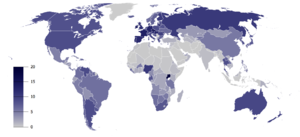
Australia
Marijuana is the most popular drug in Australia tried by more than 7 million Australians in a lifetime, with ecstasy being the second most popular tried by 2 million people. By age 20, 37% of the population have tried those drugs, and by age 40, this is just shy of 60%.
Ireland
A 2008 study in the Republic of Ireland found that for teenagers aged 15–19:
- 86% drink alcohol (the legal alcohol purchase age and public drinking age is 18.)
- 51% binge drink (defined as five drinks or more at occasion) at least once a month.
- 19% binge drink once a week.
- On a typical drinking occasion, the average amount of alcoholic beverages consumed is 5.75 pints.
- The average age for taking a first alcoholic drink is 13½.
- 50% have used illegal drugs at least once.
- 41% have used cannabis at least once.
- The average age of first illegal drug use is 14½.
Northern Ireland has the highest rate of recreational drug use among teenagers
United States
In the 1960s, the number of Americans who had tried cannabis at least once increased over twentyfold. In 1969, the FBI reported that between the years 1966 and 1968, the number of arrests for marijuana possession, which had been outlawed throughout the United States under Marihuana Tax Act of 1937, had increased by 98%. Despite acknowledgement that drug use was greatly growing among America's youth during the late 1960s, surveys have suggested that only as much as 4% of the American population had ever smoked marijuana by 1969. By 1972, however, that number would increase to 12%. That number would then double by 1977.
The Controlled Substances Act of 1970 classified marijuana along with heroin and LSD as a Schedule I drug, i.e., having the relatively highest abuse potential and no accepted medical use. Most marijuana at that time came from Mexico, but in 1975 the Mexican government agreed to eradicate the crop by spraying it with the herbicide paraquat, raising fears of toxic side effects. Colombia then became the main supplier. The "zero tolerance" climate of the Reagan and Bush administrations (1981–93) resulted in passage of strict laws and mandatory sentences for possession of marijuana and in heightened vigilance against smuggling at the southern borders. The "war on drugs" thus brought with it a shift from reliance on imported supplies to domestic cultivation (particularly in Hawaii and California). Beginning in 1982 the Drug Enforcement Administration turned increased attention to marijuana farms in the United States, and there was a shift to the indoor growing of plants specially developed for small size and high yield. After over a decade of decreasing use, marijuana smoking began an upward trend once more in the early 1990s, especially among teenagers, but by the end of the decade this upswing had leveled off well below former peaks of use.
Movements
There have been many movements calling for the legalization of recreational drugs (the most notable one being cannabis legalization). Examples of such movements are the Worldwide Marijuana March, Hemp Day, and 4/20. Several movements that call for the legalization of drugs, not from an argument of their safety but rather from an argument that this issue should be considered a medical one and not a criminal one, also exist, primarily in North America. One such organization is the Students for Sensible Drug Policy (SSDP). The British drug reform group Transform believes that taxation and regulation of drugs by the government would significantly decrease crime while increasing the health of drug users and addicts. Impact varies from country to country, depending on its legality. Also, there are many anti-drug movements, specifically Straight Edge and The Partnership For A Drug Free America, calling for the continuation of its current illegality.
In a blog article titled "Drugs and the meaning of life", author and neuroscientist Sam Harris argues "The fact that we pointlessly ruin the lives of nonviolent drug users by incarcerating them, at enormous expense, constitutes one of the great moral failures of our time." He says that he dreads the thought of his daughter's ever taking an interest in crack cocaine. On the other hand, he feels that she might be missing out if she never tried psychedelics like psilocybin. Harris also laments that a drug's legality, social status, and risks of harm rarely correlate reasonably.
Risks
The amount and type of risks that come with recreational drug use vary widely with the drug. There are many factors in the environment and the user that interact with each drug differently. Overall, some studies suggest that alcohol is one of the most dangerous of all recreational drugs; only heroin, crack cocaine, and methamphetamines are judged to be more harmful. However, studies which focus on a moderate level of alcohol consumption have concluded that there can be substantial health benefits from its use, such as decreased risk of cardiac disease, stroke and cognitive decline. Experts in the UK offer that some drugs that may be causing less harm, to fewer users (although they are also used less frequently in the first place) include Cannabis, psilocybin mushrooms, LSD, and ecstasy. These drugs are not without their own particular risks.
Responsible use
Main article: Responsible drug useThe concept of "responsible drug use" is that a person can use drugs recreationally or otherwise with reduced or eliminated risk of negatively affecting other aspects of one's life or other people's lives. Advocates of this philosophy point to the many well-known artists and intellectuals who have used drugs, experimentally or otherwise, with few detrimental effects on their lives. Responsible drug use becomes drug abuse only when the use of the substance significantly interferes with the user's daily life.
Responsible drug use advocates that users should not take drugs at the same time as activities such as driving, swimming, operating machinery, or other activities that are unsafe without a sober state. Responsible drug use is emphasized as a primary prevention technique in harm-reduction drug policies. Harm-reduction policies were popularized in the late 1980s, although they began in the 1970s counter-culture where users were distributed cartoons explaining responsible drug use and consequences of irresponsible drug use. Another issue is that the illegality of drugs in itself may also cause social and economic consequences for those using them — the drugs may be "cut" with adulterants and the purity varies wildly, making overdoses more likely — and legal regulation of drug production and distribution would alleviate these and other dangers of illegal drug use. Harm reduction seeks to minimize the harm that can occur through the use of various drugs, whether legal (e.g., alcohol and nicotine), or illegal (e.g., heroin and cocaine). For example, people who inject illicit drugs can minimize harm to both themselves and members of the community through proper injecting technique, using new needles and syringes each time, and proper disposal of all injecting equipment.
Usage of recreational drugs has been associated with various dispositions ranging from curiosity to boredom or low self-esteem, a want to be risky, to meditate, to escape from or cope with difficulties, to relax, to increase energy and decrease sluggishness, and to improve focus or concentration. Psychological disorders such as depression, trauma, social anxiety, and schizophrenia are also seen as promoters of drug use. Additionally, users seek positives such as a disinhibiting effect on socialization or an aphrodisiac effect.
Prevention
Evidence is insufficient to tell if behavioral interventions help prevent recreational drug use in children.
Gallery
-
 Peyote cactus, containing mescaline
Peyote cactus, containing mescaline
-
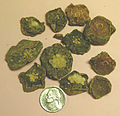 Peyote buttons seized by police in California
Peyote buttons seized by police in California
-
 Cannabis plant
Cannabis plant
-
 Dried marijuana bud
Dried marijuana bud
-
 Psilocybe semilanceata is a saprobic grassland species
Psilocybe semilanceata is a saprobic grassland species
-
 A collection from The Netherlands
A collection from The Netherlands
-
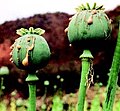 Opium poppy seed pods exuding latex, containing morphine
Opium poppy seed pods exuding latex, containing morphine
-
 Martini, a cocktail containing alcohol
Martini, a cocktail containing alcohol
-
 Cappuccino, a coffee drink containing caffeine
Cappuccino, a coffee drink containing caffeine
-
 Bottle of LSD from a Swiss clinical trial for anxiety, c. 2007
Bottle of LSD from a Swiss clinical trial for anxiety, c. 2007
-
 A lit cigarette, containing nicotine
A lit cigarette, containing nicotine
-
 A pile of cocaine hydrochloride
A pile of cocaine hydrochloride
-
 MDMA pills, known as 'Ecstasy'
MDMA pills, known as 'Ecstasy'
-
Preparing heroin for injection
-
 Crystals of methamphetamine
Crystals of methamphetamine
-
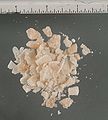 Rocks of crack cocaine, a freebase version of cocaine
Rocks of crack cocaine, a freebase version of cocaine
-
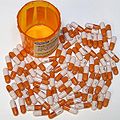 Amphetamine pills, commonly prescribed as Adderall
Amphetamine pills, commonly prescribed as Adderall
-
 Ayahuasca, a decoction prepared with Banisteriopsis caapi
Ayahuasca, a decoction prepared with Banisteriopsis caapi
-
Ketamine hydrochloride crystals
-
 Dimethyltryptamine (DMT) in a bag
Dimethyltryptamine (DMT) in a bag
- Phenobarbital, a long-acting barbiturate Phenobarbital, a long-acting barbiturate
-
 Capsules of Bromazepam, a benzodiazepine
Capsules of Bromazepam, a benzodiazepine
-
 Tabs of acid, lysergic acid diethylamide (LSD)
Tabs of acid, lysergic acid diethylamide (LSD)
-
 Homeless children from Keningau, in Borneo, sniffing glue
Homeless children from Keningau, in Borneo, sniffing glue
-
 Amyl nitrite
Amyl nitrite
-
 Salvia divinorum
Salvia divinorum
-
 Coca tea
Coca tea
-
 Man in Yemen selling khat, a stimulant
Man in Yemen selling khat, a stimulant
-
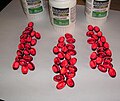 DXM, a cough medicine which acts as a dissociative hallucinogen in large enough doses.
DXM, a cough medicine which acts as a dissociative hallucinogen in large enough doses.
-
 Nitrous oxide canisters
Nitrous oxide canisters
See also
- Counterfeit drug
- Demand reduction
- Drug education
- Entheogen
- Harm reduction
- Illegal drug trade
- Prohibition (drugs)
- Purple drank
- Recreational use of dextromethorphan
- Recreational use of ketamine
References
- ^ Matt Sledge (4 August 2013). "The Drug War And Mass Incarceration By The Numbers". Huffington Post. Retrieved September 2014.
{{cite web}}: Check date values in:|accessdate=(help) - ALEX PAREENE (APR 15, 2011). "DEA head: A thousand dead children means we're winning war on drugs". Salon. Retrieved September 2014.
{{cite web}}: Check date values in:|accessdate=and|date=(help) - Plant & Plant (1992). Risk-takers: Alcohol, Drugs, Sex, and Youth. p. 2.
- "Drug War Statistics". Drug Policy Alliance. Retrieved September 2014.
{{cite web}}: Check date values in:|accessdate=(help) - "INCARCERATION AND RACE". Human Rights Watch. Retrieved September 2014.
{{cite web}}: Check date values in:|accessdate=(help) - "Global Commission on Drug Policy Offers Reckless, Vague Drug Legalization Proposal; Current Drug Policy Should Be Improved through Innovative Linkage of Prevention, Treatment and the Criminal Justice System" (PDF). Institute for Behavior and Health. 2011. Retrieved September 2014.
{{cite web}}: Check date values in:|accessdate=(help) - Andre Mayer (2 Aug 2013). "Uruguay's pot legalization could be 'tipping point' in war on drugs". CBC News. Retrieved September 2014.
{{cite web}}: Check date values in:|accessdate=(help) - DAMIEN CAVE (5 January 2014). "As cannabis is widely legalised, China cashes in on an unprecedented boom". The Independent. Retrieved September 2014.
{{cite web}}: Check date values in:|accessdate=(help) - Ken Parks (6 May 2014). "Uruguay Opens the Gates to Legalized Pot". Wall Street Journal. Retrieved September 2014.
{{cite web}}: Check date values in:|accessdate=(help) - "U.N. Still Upset Over Uruguay Legalizing Weed". Huffington Post. 3 April 2014. Retrieved September 2014.
{{cite web}}: Check date values in:|accessdate=(help) - R. J. Sullivan & E. H. Hagen (2000). "Psychotropic substance-seeking: evolutionary pathology or adaptation?" (PDF). Retrieved September 2014.
{{cite web}}: Check date values in:|accessdate=(help) - Tammy Saah (2005). "The evolutionary origins and significance of drug addiction". US National Library of Medicine. Retrieved September 2014.
{{cite web}}: Check date values in:|accessdate=(help) - Roger J Sullivan, Edward H Hagen and Peter Hammerstein (2008). "Revealing the paradox of drug reward in human evolution". The Royal Society. Retrieved September 2014.
{{cite web}}: Check date values in:|accessdate=(help) - Odyssey IX, translated by Samuel Butler.
- Herodotus, Histories, iv.177 (on-line text).
- Rob Arthur (16 November 2009). "Classical Drug Use: Greek and Roman Drug Freedom". Narco Polo. Retrieved September 2014.
{{cite web}}: Check date values in:|accessdate=(help) - Hillman, David (2008). The Chemical Muse: Drug Use and the Roots of Western Civilization.
- Li, Hui-Lin (1974). An archaeological and historical account of cannabis in China.
- Jann Gumbiner (10 May 2011). "History of Cannabis in Ancient China". Psychology Today. Retrieved September 2014.
{{cite web}}: Check date values in:|accessdate=(help) - Christie, Anthony (1968). Chinese Mythology. p. 87.
- Needham, Joseph (1974). Science and Civilisation in China: Volume 5, Chemistry and Chemical Technology; Part 2, Spagyrical Discovery and Invention: Magisteries of Gold and Immortality. Cambridge University Press. p. 154.
- Jonathan Wynne-Jones (19 October 2008). "Stone Age man took drugs, say scientists". The Telegraph. Retrieved August 2014.
{{cite web}}: Check date values in:|accessdate=(help) - ^ "The Global Drug Survey 2014 findings". Global Drug Survey. 2014. Retrieved September 2014.
{{cite web}}: Check date values in:|accessdate=(help) - http://monographs.iarc.fr/ENG/Classification/ClassificationsGroupOrder.pdf
- Wonnacott S (February 1997). "Presynaptic nicotinic ACh receptors". Trends in neurosciences. 20 (2): 92–8. doi:10.1016/S0166-2236(96)10073-4. PMID 9023878.
- Campbell, V A; Gowran, A (2009). "Alzheimer's disease; taking the edge off with cannabinoids?". British Journal of Pharmacology. 152 (5): 655–62. doi:10.1038/sj.bjp.0707446. PMC 2190031. PMID 17828287.
- Eubanks, Lisa M.; Rogers, Claude J.; Beuscher Ae, 4th; Koob, George F.; Olson, Arthur J.; Dickerson, Tobin J.; Janda, Kim D. (2006). "A Molecular Link between the Active Component of Marijuana and Alzheimer's Disease Pathology". Molecular Pharmaceutics. 3 (6): 773–7. doi:10.1021/mp060066m. PMC 2562334. PMID 17140265.
{{cite journal}}: CS1 maint: numeric names: authors list (link) - Jiang, W.; Zhang, Y; Xiao, L; Van Cleemput, J; Ji, SP; Bai, G; Zhang, X (2005). "Cannabinoids promote embryonic and adult hippocampus neurogenesis and produce anxiolytic- and antidepressant-like effects". Journal of Clinical Investigation. 115 (11): 3104–16. doi:10.1172/JCI25509. PMC 1253627. PMID 16224541.
- Pharmacokinetics and Pharmacodynamics of Methylecgonidine, a Crack Cocaine Pyrolyzate - Scheidweiler et al. 307 (3): 1179 Figure IG6 - Journal of Pharmacology And Experimental Therapeutics
- British Journal of Pharmacology - Abstract of article: Evidence for cocaine and methylecgonidine stimulation of M2 muscarinic receptors in cultured human embryonic lung cells
- Studies on Hydrolytic and Oxidative Metabolic Pathways of Anhydroecgonine Methyl Ester (Methylecgonidine) Using Microsomal Preparations from Rat Organs (Chemical Research in Toxicology/ACS Publications)
- John Philip Jenkins. "methamphetamine (drug) – Britannica Online Encyclopedia". Britannica.com. Retrieved 29 January 2012.
- Cruickshank CC, Dyer KR (July 2009). "A review of the clinical pharmacology of methamphetamine". Addiction. 104 (7): 1085–1099. doi:10.1111/j.1360-0443.2009.02564.x. PMID 19426289.
- Malenka RC, Nestler EJ, Hyman SE (2009). "15". In Sydor A, Brown RY (ed.). Molecular Neuropharmacology: A Foundation for Clinical Neuroscience (2nd ed.). New York: McGraw-Hill Medical. p. 370. ISBN 978-0-07-148127-4.
Unlike cocaine and amphetamine, methamphetamine is directly toxic to midbrain dopamine neurons.
{{cite book}}: CS1 maint: multiple names: authors list (link) - Hofmann A, Heim R, Tscherter H. (1963). "Phytochimie – présence de la psilocybine dans une espèce européenne d'agaric, le Psilocybe semilanceata Fr." . Comptes rendus hebdomadaires des séances de l'Académie des sciences (in French) 257 (1). pp. 10–12.
{{cite book}}: CS1 maint: multiple names: authors list (link) - Albert Hofmann. "LSD My Problem Child". Retrieved 19 April 2010.
- "Brecher, Edward M; et al. (1972). "How LSD was popularized". Consumer Reports/Drug Library". Druglibrary.org. Retrieved 20 June 2012.
- United States Congress (24 October 1968). "Staggers-Dodd Bill, Public Law 90-639" (PDF). Retrieved 8 September 2009.
- "Erowid DMT (Dimethyltryptamine) Vault". Erowid.org. Retrieved 20 September 2012.
- Richard Lovett (24 September 2005). "Coffee: The demon drink?". Retrieved 1 May 2014.
- "MSDS Glossary". Retrieved 1 January 2009.
- Christopher J. Morgan and Abdulla A.-B. Badawy. "Alcohol-induced euphoria: exclusion of serotonin." Alcohol and Alcoholism (2001) 36 (1): 22–25.
- Cotter, Malik. "Herbs Make It Easy to Catch Some Zs". Nutrition Science News. Penton Media. Retrieved 27 July 2011.
- Foster, Steven (2002). A field guide to Western Medicinal Plants and Herbs. New York: Houghton Mifflin Company. p. 58.
- Alan W. Cuthbert "stimulants" The Oxford Companion to the Body. Ed. Colin Blakemore and Sheila Jennett. Oxford University Press, 2001. Oxford Reference Online. Oxford University Press. 28 July 2011
- Rhodri Hayward "euphoria" The Oxford Companion to the Body. Ed. Colin Blakemore and Sheila Jennett. Oxford University Press, 2001. Oxford Reference Online. Oxford University Press. 28 July 2011
- "ecstasy" World Encyclopedia. Philip's, 2008. Oxford Reference Online. Oxford University Press. 28 July 2011
- "opium" World Encyclopedia. Philip's, 2008. Oxford Reference Online. Oxford University Press. 28 July 2011
- "Dorlands Medical Dictionary:psychostimulant".
- ^ Epidemiology of Inhalant Abuse: An International Perspective, 148 Cite error: The named reference "autogenerated1" was defined multiple times with different content (see the help page).
- http://www.gdcada.org/statistics/inhalants.htm
- Global Status Report on Alcohol 2004
- David Farber (2004). The Sixties Chronicle. Legacy Publishing. p. 432. ISBN 141271009X.
{{cite book}}:|access-date=requires|url=(help) - ^ Jennifer Robison, Gallup.com, 2 July 2002, Accessed 13 November 2013
- ^ http://www.infoplease.com/encyclopedia/science/marijuana-history-marijuana-use.html
- http://www.tdpf.org.uk/Policy_General_AftertheWaronDrugsReport.htm
- samharris.org, blog, "Drugs and the meaning of life".
- Stampfer MJ, Kang JH, Chen J, Cherry R, Grodstein F (January 2005). "Effects of moderate alcohol consumption on cognitive function in women". N Engl J Med. 352 (3): 245–53. doi:10.1056/NEJMoa041152. PMID 15659724.
{{cite journal}}: CS1 maint: multiple names: authors list (link) - Hines LM, Stampfer MJ, Ma J (February 2001). "Genetic variation in alcohol dehydrogenase and the beneficial effect of moderate alcohol consumption on myocardial infarction". N Engl J Med. 344 (8): 549–55. doi:10.1056/NEJM200102223440802. PMID 11207350.
{{cite journal}}: CS1 maint: multiple names: authors list (link) - Berger K, Ajani UA, Kase CS (November 1999). "Light-to-moderate alcohol consumption and risk of stroke among U.S. male physicians". N Engl J Med. 341 (21): 1557–64. doi:10.1056/NEJM199911183412101. PMID 10564684.
{{cite journal}}: CS1 maint: multiple names: authors list (link) - Mukamal KJ, Conigrave KM, Mittleman MA (January 2003). "Roles of drinking pattern and type of alcohol consumed in coronary heart disease in men". N Engl J Med. 348 (2): 109–18. doi:10.1056/NEJMoa022095. PMID 12519921.
{{cite journal}}: CS1 maint: multiple names: authors list (link) - "Drug harms in the UK: a multi-criteria decision analysis", by David Nutt, Leslie King and Lawrence Phillips, on behalf of the Independent Scientific Committee on Drugs. The Lancet.
- Charles E. Faupel; Alan M. Horowitz; Greg S. Weaver. The Sociology of American Drug Use. McGraw Hill. p. 366.
- "Failed states and failed policies, How to stop the drug wars". The Economist. 5 March 2009. Retrieved 10 March 2009.
- Working with Drug and Alcohol Users, Tony White – 2012 – Page 77
- Over the Influence: The Harm Reduction Guide for Managing Drugs and Alcohol, Patt Denning, Jeannie Little, Adina Glickman – 2004
- Situational Prison Control: Crime Prevention in Correctional Institutions, p 159, Richard Wortley – 2002
- Moyer, VA; U.S. Preventive Services Task, Force (6 May 2014). "Primary care behavioral interventions to reduce illicit drug and nonmedical pharmaceutical use in children and adolescents: U.S. Preventive Services Task Force recommendation statement". Annals of internal medicine. 160 (9): 634–9. PMID 24615535.
External links
- The International Network of People who Use Drugs (INPUD):Timeline of Events in the History of Drugs
- BBC Headroom: Are drugs becoming a problem?
- Drugs of Abuse Drug Enforcement Administration
- National Institute on Drug Abuse – The science of drug abuse and addiction
- Synthetic Drugs: Overview and Issues for Congress Congressional Research Service
- National Institute on Drug Abuse: "NIDA for Teens".